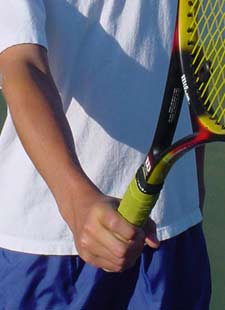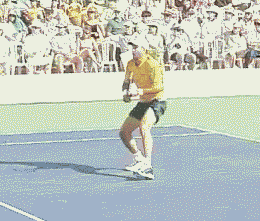|
TennisOne Lessons
Last month, I wrote on the similarities of the backhand volley mechanics among top players including Rafter, Sampras and Hewitt. In discussing these similarities, I presented reasons why these champions use certain methods and why all players should explore these methods for themselves. Here, I will break down the core elements that most skilled players utilize in the production of successful forehand volleys through the same use of visual comparisons of top players. Essentially the forehand volley is a “mirrored image” of the backhand volley. While there are a couple of key components that differ, each stroke's components mimic the other on many levels. GripAs most books and pros will attest, skilled players use the Continental grip for almost all their volleys.
Although, in some cases, skilled players will attack certain volleys with a slight Eastern forehand grip. These usually include higher volleys or swinging topspin volleys. However, almost all top players exclusively use a Continental grip for low volleys and especially for angle volleys. There are a number of top players who do indeed use the Eastern forehand grip for mid-range volleys. However, these players usually still utilize a similar swing pattern as those who use the continental. (That is, they use a short, slicing drive as opposed to the typical upward stroke most beginners use.) Since the topspin volleys that pros hit utilize the same basic swing pattern as a topspin groundstroke, we will only be addressing the more conventional blocking-type or short-stroke volley here in this article. Players who learn to volley using the Eastern grip for their forehand volley inevitably hit their volleys with topspin. This is even more evident on quick volleys when reaction time is limited. This occurs because the natural swing pattern that players associate with the Eastern grip is topspin. After all, the Eastern forehand grip is considered the foundation grip for topspin groundstrokes, not underspin slice strokes.
I have seen hundreds of players who know they should slice the volley, hit with topspin because of this natural swing pattern the Eastern grip produces. The Continental grip keeps the racquet parallel with the forearm while
the Eastern Grip creates nearly a 90 degree relationship to the forearm.
The Continental generally feels weak - a major reason so many books and pros promote the Eastern grip to beginners…it feels more comfortable to most beginner players. However, it is far better to experience some discomfort now than the incapacitating discomfort of trying to change an established Eastern forehand grip! Here are a couple tools for you to quickly gain comfort and control of the racquet while holding the Continental grip. Two important drills I use to help students gain comfort and control using the continental grip involve bouncing tennis balls off the racquet. Start by holding the racquet with the Continental grip. Now try to bounce about 100 consecutive bounces, both off the ground and off the racquet in the air as shown on the right. This will build the fine muscle control of the hand and forearm as well as develop an affinity for the Continental grip. (These drills also help decrease the chance of "tennis elbow" as both are low-impact drills that warm up the small muscle groups that are prone to irritating minor injuries.) When bouncing the ball down on the court, kneel down so the racquet and the arm can remain almost parallel. Many instructors recommend standing up while doing these bounces. However, standing almost forces players to use an Eastern grip!
On up bounces, (do these standing up), keep the racquet and arm parallel as well, and keep the racquet elbow straight. This drill facilitates the development of a proper volley while also developing a level of comfort using the continental grip. On the issue of strength, if a player feels weak while hitting volleys, it is usually a good sign they are doing something wrong mechanically. Strength has nothing to do with it! In seminars and clinics, I demonstrate both the forehand and backhand volley while holding the racquet using only my index finger and thumb. As a result of seeing crisp, deep volleys using only these two fingers, students begin to recognize that strength is not the issue when hitting volleys. (Certainly for hard hit balls and balls that require you to reach, there is an element of strength necessary to control the racquet. However, even in these instances, a good volley rarely needs the kind of strength players sometimes imagine.)
First MoveAs with the backhand, the first move is the shoulder turn. Usually, the forehand volley turn is slightly less than that which is necessary for a proper backhand. This is because of the arm and shoulder position on the two strokes. On the forehand, the dominant arm and shoulder is back in comparison to the center point of the body On the backhand, these two body parts are in front of the player's center point. Some pros advise students to take the racquet back to the side first. However, this sequence causes many to over swing. The reason is simple: if you take the racquet back to the side first, then turn the shoulders, the racquet will be pointing towards the back fence. (Note how Sampras turns his shoulders but his racquet face remains square to the ball, not pointing back towards the fence. Over rotating the backswing is perhaps the most prevalent mistake made by players on both the forehand and backhand volleys.) Using the Continental grip, the turn of the shoulders sets the face of
the racquet towards the target.
StepWith volleys, when there is time to set up the feet, the left leg will step across the body facilitating the sideways position (right-handed players). This is a critical factor in directing the shot without pushing. As with the backhand volley, the ability to stroke the volley towards the target depends on the body’s ability to hit while sideways to the target. If you watch skilled players angle the volley crosscourt, they will actually align their bodies so that they are facing away from the target during contact. Skilled players can often be seen actually stepping out with what I call the “wrong foot”. (Right foot for right-handed players.) The issue is that skilled players have developed the proper shoulder position regardless of which foot they step with. Beginners to intermediate players often step out with this wrong foot without executing the shoulder turn. This results in the player pushing the volley away from the body instead of the arm moving across the body.
As with the backhand volley, the forehand volley is hit almost parallel with the front knee. This can vary from player to player, however. For example, players who do hit using a slight Eastern forehand grip will tend to push out their hand in front of them when attacking a short floater. It is important that players learn to move their feet and body to attack balls instead of simply leaning and reaching forward. This is a common problem for many and it tends to make players hit the ball flat and down into the net. Again, as with the backhand, most forehand volleys are hit with a slight slicing motion. The amount of slice can vary due to situations and desired effect. Some players will flatten out a volley with just a minimal amount of slice (usually on high volleys). On lower volleys, players will usually add a greater amount of slice to the ball so they can hit it firmly and still keep it in the court. The action of slicing the ball will help maintain the angle of racquet face during contact. Without the slicing action, players often hit down too much, volleying a ball that is high above the net into the net.
Key Position Points: Unlike the backhand where the player should try to keep the hitting arm straight, the arm on a forehand volley should be slightly bent. Attempting to keep the eyes parallel with the ball height at contact is often helpful because it helps players stay down during contact (obviously, this will be impossible to accomplish for low balls). FinishPros use a decidedly longer finish than I recommend for most beginners or high intermediate players. For beginners or intermediate players, a long follow-through is often preceded by too big of a backswing and this leads to a bigger swing than they can control. I recommend holding the finish momentarily. This allows a player to check the racquet’s position in relation to the arm and body, as well as the racquet’s face after contact. (If the player is rolling the racquet or hitting topspin, this will be revealed by a closed racquet face after contact.) This "freezing" of the racquet at or near contact is a great cue to prevent overswinging. Notice how the pros finish their volleys in the ProStrokes Gallery. Not one finishes with the racquet head rolling over the ball. Some will slide further under the ball for their finish, (See Rafter's volley above), yet none finish with the racquet face closing. Even a flat volley, such as the one McEnroe hits (see animation below) is struck without the racquet changing its plane through the course of the volley.
Back LegA common problem, especially for beginners, is the positioning of the back leg back during the forehand volley. Often, players will thrust their hand out to hit the volley instead of moving their feet to the ball. This forward movement of the hand and arm usually causes the player to be out in front of their center of gravity. Thus, the player has to quickly swing their leg around to help prevent him from falling on his face! This rotation of the hips and back leg causes players to open up too early. Top players can actually be seen kicking this back leg back slightly (See McEnroe's volley) or simply dragging the back foot for a moment during contact. (See Sampras below.) These two moves, similar to what the back foot/leg does on a good serve, is very apparent among skilled players. ConclusionSuccessful forehand volleys are those that can be hit with regularity to a variety of targets from a variety of positions. Players who execute volleys using the Continental grip usually progress to higher advanced stages of play due to their ability to hit with greater variety, especially low volleys and angle volleys.
Eastern grips are often used, even by the pros. Yet, it is clear that almost all skilled players will hit the majority of their volleys using the Continental grip. More importantly, in players looking to develop a skilled volley, the use of the Eastern grips may delay or even prohibit this acquisition of a quality volley. Even when skilled players used the Eastern forehand grip to volley, the emphasis is a slice like pattern. Once the volley grip and short stroke are mastered, players must utilize their feet to maximize the position and body relationship to the ball. Finally, you will see a variety of forehand volleys among even top players. However, if you look closely, you will identify these core elements even within the diversity and idiosyncrasies among the many highly skilled performers.
|
Last Updated 7/15/02. To contact us, please email to: webmaster@tennisone.com TennisONE is a registered trademark of TennisONE and SportsWeb ONE; Copyright 1995. All rights reserved. |
|||||||||||||||||||













 Your comments are welcome. Let us know what you think about this article by
Your comments are welcome. Let us know what you think about this article by